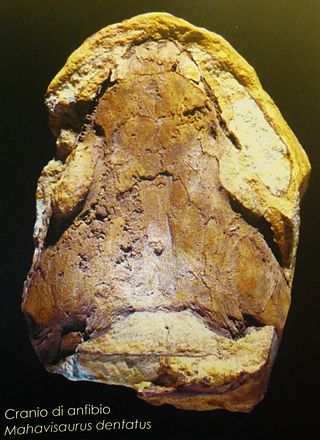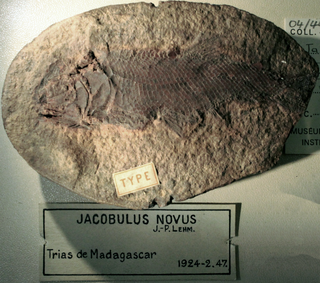
Hovasaurus is an extinct genus of basal diapsid reptile. It lived in what is now Madagascar during the Late Permian and Early Triassic, being a survivor of the Permian–Triassic extinction event and the paleontologically youngest member of the Tangasauridae. Fossils have been found in the Permian Lower and Triassic Middle Sakamena Formations of the Sakamena Group, where it is amongst the commonest fossils. Its morphology suggests an aquatic ecology.

Mahavisaurus is an extinct genus of rhytidosteid temnospondyl from the early Triassic period of Iraro, Madagascar. It is known from the holotype MNHN MAE 3037, a nearly complete skull, recovered from the Middle Sakamena Formation. This genus was named by J. P. Lehman in 1966, and the type species is Mahavisaurus dentatus.
Oshunia is an extinct genus of prehistoric bony fish that lived during the Albian. Fossils of the genus were found in the Romualdo Formation of the Araripe Basin, northeastern Brazil. Other authors assign a Cenomanian age to the fish.
Stensionotus is an extinct genus of prehistoric bony fish that lived during the Early Triassic epoch in what is now Madagascar and China. It belongs to Parasemionotidae together with Albertonia, Candelarialepis, Jacobulus, Lehmanotus, Parasemionotus, Qingshania, Suius, Thomasinotus and Watsonulus. It is named after Erik Stensiö.

Watsonulus is an extinct genus of prehistoric ray-finned fish that lived during the Early Triassic epoch in what is now Madagascar. It may have also existed in what is now Himachal Pradesh, India, during the Induan age. The type species, described by Jean Piveteau, is Watsonia eugnathoides. Because "Watsonia" was preoccupied, the new genus name Watsonulus was later erected. The genus is named after David Meredith Seares Watson.
Lehmanotus is an extinct genus of prehistoric bony fish that lived during the Early Triassic epoch in what is now Madagascar. It belongs to Parasemionotidae together with Albertonia, Candelarialepis, Jacobulus, Parasemionotus, Qingshania, Stensioenotus, Suius, Thomasinotus and Watsonulus. It is named after Jean-Pierre Lehman.
Broughia is an extinct genus of marine holostean ray-finned fish that lived during the Induan age of the Early Triassic epoch in what is now Greenland. Fossils were found in the Wordie Creek Formation. A potential concurrent record is also known from Madagascar.

Jacobulus is an extinct genus of prehistoric ray-finned fish that lived during the Early Triassic epoch in what is now northern Madagascar 252.3 to 251.3 million years ago. The type species is Jacobulus novus (monotypy). It was a small fish less than 10 centimetres (3.9 in) in length. J. novus ecology was a grazer-detritivore. It belongs to the Parasemionotidae together with Albertonia, Candelarialepis, Icarealcyon, Lehmanotus, Parasemionotus, Qingshania, Stensioenotus, Suius, Thomasinotus, and Watsonulus.

Australosomus is an extinct genus of prehistoric ray-finned fish that lived during the Early Triassic epoch in what is now Greenland, Kenya, Tanzania, Madagascar, South Africa and Canada.
Helmolepis is an extinct genus of ray-finned fish that lived during the Early Triassic epoch in what is now Greenland, Madagascar and Canada. Species of Helmolepis are small. This genus is closely related with Platysiagum.
Helichthys is an extinct genus of prehistoric bony fish that lived during the Early Triassic epoch in what is now South Africa.
Gyrolepidoides is an extinct genus of prehistoric bony fish that lived during the Late Triassic epoch in what is now Mendoza, Argentina.
Agecephalichthys is an extinct genus of prehistoric freshwater "palaeonisciform" ray-finned fish that lived during the Anisian age. It contains a single species, A. granulatus from the Hawkesbury Sandstone in what is now New South Wales, Australia.

Ecrinesomus is an extinct genus of prehistoric bobasatraniiform ray-finned fish that lived during the Induan age of the Early Triassic epoch in what is now Madagascar.

Parasemionotus is an extinct genus of prehistoric bony fish that lived in the Induan age of the Early Triassic epoch in what is now Madagascar. It is the name giving genus of the family Parasemionotidae and the order Parasemionotiformes.

Paracentrophorus is an extinct genus of prehistoric ray-finned fish that lived during the Induan age of the Early Triassic epoch in what is now Madagascar. The type species is Paracentrophorus madagascariensis (monotypy).

Thomasinotus is an extinct genus of small prehistoric ray-finned fish that lived in the Induan age of the Early Triassic epoch in what is now Madagascar. It belongs to the early neopterygian family Parasemionotidae together with Albertonia, Candelarialepis, Icarealcyon, Jacobulus, Lehmanotus, Parasemionotus, Qingshania, Stensioenotus, Suius, and Watsonulus.
Luganoia is an extinct genus of prehistoric bony fish that lived during the Anisian and Ladinian ages of the Middle Triassic epoch. Fossils were recovered from the Besano Formation of Monte San Giorgio and Besano area and from the Zhuganpo Member of Guizhou, South China. It was also reported from the Ladinian of Spain.

Bobasatrania is an extinct genus of prehistoric marine ray-finned fish that survived the Permian-Triassic extinction event. Fossils of Bobasatrania were found in beds of Changhsingian to Ladinian age. It was most speciose during the Early Triassic.
Pristisomus is an extinct genus of prehistoric bony fish that lived during the Anisian age in what is now New South Wales, Australia. Fossils are derived from the Sydney sandstone.














